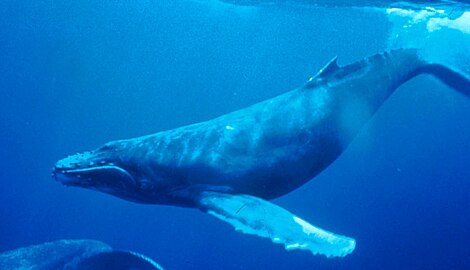en.wikipedia.org
Always private
DuckDuckGo never tracks your searches.
Learn MoreYou can hide this reminder in Search Settings
All regions
Argentina
Australia
Austria
Belgium (fr)
Belgium (nl)
Brazil
Bulgaria
Canada (en)
Canada (fr)
Catalonia
Chile
China
Colombia
Croatia
Czech Republic
Denmark
Estonia
Finland
France
Germany
Greece
Hong Kong
Hungary
Iceland
India (en)
Indonesia (en)
Ireland
Israel (en)
Italy
Japan
Korea
Latvia
Lithuania
Malaysia (en)
Mexico
Netherlands
New Zealand
Norway
Pakistan (en)
Peru
Philippines (en)
Poland
Portugal
Romania
Russia
Saudi Arabia
Singapore
Slovakia
Slovenia
South Africa
Spain (ca)
Spain (es)
Sweden
Switzerland (de)
Switzerland (fr)
Taiwan
Thailand (en)
Turkey
Ukraine
United Kingdom
US (English)
US (Spanish)
Vietnam (en)
Safe search: moderate
Strict
Moderate
Off
Any time
- The humpback whale (Megaptera novaeangliae) is a species of baleen whale.It is a rorqual (a member of the family Balaenopteridae) and is the only species in the genus Megaptera.Adults range in length from 14-17 m (46-56 ft) and weigh up to 40 metric tons (44 short tons). The humpback has a distinctive body shape, with long pectoral fins and tubercles on its head.
iwc.int
International Whaling Commission
https://iwc.int › about-whales › estimate
The IWC presents a 'best estimate' accompanied by a 95% 'confidence Interval' showing a range of plausible values for the population's actual abundance. As an example (taken from the table below) the 1991/92-2003/4 abundance estimate for Southern Hemisphere blue whales is 2,300 with a 95% confidence interval of 1,150-4,500.fisheries.noaa.gov
The Years of the North Atlantic Humpback Project in 1992 to 1993 and the follow-up project, More North Atlantic Humpbacks, in 2003 to 2005 were international collaborations to monitor humpback whale populations, investigate human-caused deaths, and conduct various other surveys, including research on humpback songs, across many humpback habitats.- News for humpback whale population
discovermagazine.com
Oct 26, 2023Prior to commercial whaling, the sperm whale population was likely just under two million in 1710. After the IWC issued the moratorium in 1986, the population began to rebuild. In 1993, there were an estimated 736,000 sperm whales. By 2022, the population had increased to more than 844,000.fish.uw.edu
School of Aquatic and Fishery Sciences
https://fish.uw.edu › 2024 › 08 › rapid-increase-rates-in-large-whale-populations-continue-until-they-near-carrying-capacity
Aug 26, 2024The humpback whale (Megaptera novaeangliae) is a species of baleen whale.Standard ecological theory, also known as density dependence, holds that as populations increase, they compete more for food, and eventually it gets harder to find food, resulting in slower growth in body size, lower survival, and lower birth rates, all of which result in slower population recovery at higher abundance.usatoday.com
Oct 16, 2019After being almost wiped out by whaling in the 20th century, a humpback whale population off the coast of South America has come back from the brink of extinction. In the late 1950s there were ...cbc.ca
Mar 4, 2024A sprawling international study of humpback whales in the northern Pacific has found their population has shrunk significantly since 2012 — despite the once-endangered species' remarkable ...earthsky.org
A study shows that the western South Atlantic humpback population has grown to 25,000, close to pre-whaling numbers. The recovery of these whales may have ecosystem-wide impacts on krill and other predators.fisheries.noaa.gov
What is the current humpback whale population along the Atlantic coast? The best estimate for the number of humpback whales that reside in the North Atlantic Ocean, including U.S. Atlantic coastal waters, is 10,400 to 10,752 animals. This estimate is based on a 1992-1993 international study of North Atlantic humpback whales across their known ...abc.net.au
Oct 22, 2023Experts believe the humpback whale population has reached record heights, after commercial whaling from the late 1800s to the 1960s pushed the animals to the "brink of extinction".Can’t find what you’re looking for?
Help us improve DuckDuckGo searches with your feedback
